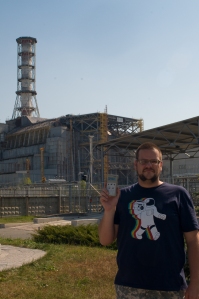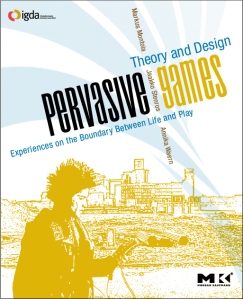The most common location-specific pastime is tourism. When it takes you to places that have restricted access it is called by many names: urban exploration, caving, buildering, infiltration and so on. These types we discussed in the book. However, when the target is catastrophe site, it is called grief tourism. Our third guest blogger, Bjarke Pedersen, went to Chernobyl.
It is 27 centigrade, partly cloudy, no wind and radiation level is 0,067 µSv/h, three times the normal background radiation. A perfect day to be in the zone.
To go to Chernobyl and especially Pripyat where the plant workers lived, is kind of the most extreme form of urban exploration. Here you have access to not a few vacant buildings, but a whole city, complete with a theatre, swim stadium, gymnasium, hospital, fire brigade — everything. 50.000 people lived in Pripyat before they were forced to move after the explosion of the power plant on the April 26, 1986. The destroyed reactor was covers by a sarcophagus of concrete to keep the highly radioactive compounds inside from spreading.
Entering the zone through a series of checkpoints with Ukrainian internal forces checking your papers feels a bit scary, but goes pretty easy. The last part of 100 Km trip from Kyiv to the zone we have not seen any traffic.
Standing in front of the power plant reactor #4 is awe inspiring. It is hard to understand that if you would have stood here on the day of the explosion you would have been killed by radiation in a few seconds. There are still people working at the plant even though the reactors were closed in December 2000. People are going round doing their business, mowing the lawn and cleaning the pathways. The radiation level is 0,497 µSv/h. We are told people only work Monday-Thursday but still get the same pay as people who work the extra day. We are at the plant for 15 minutes and are then told it is best to leave. Wonder what they tell the workers there?
Entering Pripyat feels strange. You can almost see the line of busses on the main street and the soldiers forcing the inhabitants to leave everything behind on that awful day back in 1986. The city is empty now. Well, except for the deer, lynx, boar and wolves that roam the area. Animal life is thriving in the zone. Our guide points out the main sights and gets back into the van with the driver, and find their lunch and a half bottle of vodka. We begin to explore a 5 story building. It looks like it has been a hotel. The view from the roof is amazing. Birch trees are penetrating the roof terrace, old chairs are barely standing and broken glass is everywhere. We snap some pictures and move on. So much to see.
The hight of the trip was to stand next to the iconic Pripyat ferris wheel. Ironically it has never been used since it was meant to open 4 days after the disaster. It was a strange feeling to be able to find my way in the Pripyat amusement park because I have played the Call of Duty 4: Modern Warfare game — which modelled Pripyat. It was a very pervasive experience in a way.
Urban exploring in Pripyat is different from the normal kind. Trespassing is not something you should worry about. Here you are allowed to enter the houses and buildings long abandoned.
You still have to treat it with respect and in the zone the expression “Take nothing but pictures, leave nothing but footprints” does apply, but the reasoning is different: If you take something from the zone, there is a possibility that the thing is contaminated and will kill you over time. The thing to look out for when exploring is the normal stuff: Uncovered manholes, broken glass and pointy objects. But here in the zone you also need to be very aware about the radioactive signs. There are places where very radioactive things has been buried, and you should most definitely not go there. We drove past a burial place and the Geiger counter maxed out. Not a place to have a picnic.
Leaving the zone we go through a radiation scanner to se if we are contaminated. Luckily we are not. A small truck pulls up to the checkpoint with two men in camo outfits, sunglasses and heavy gloves. They hand over their papers to the guard and are let into the zone. They do not look like urban explorers or tourists, so I ask our guide who those people are. He answers in his broken Ukrainian-English: “Stalkers, they are stalkers”.







That’s one bleak reinterpretation of the Sierra Club motto, Bjarke. But yeah, apparently back in the day there were scavengers looting electronics from Pripyat and selling them on black markets, with deadly results.
Ever since that motorcycle diary came out, albeit partially a fake, I’ve been thinking about visiting Pripyat some day. Morbidly, however, it’s one of the world’s tourist attractions that are not in danger of going away, not a day too early at least…
More on grief tourism to follow, I think I’ll blog on it later on.
– M
By: Montola on September 21, 2009
at 08:54
[…] First Tweet 2 days ago elneil Neil D eerie article: https://pervasivegames.wordpress.com/2009/09/21/chernobyl/ view retweet […]
By: Twitter Trackbacks for Chernobyl « Pervasive Games: Theory and Design [pervasivegames.wordpress.com] on Topsy.com on September 22, 2009
at 23:38
[…] guest bloggers: Bjarke Pedersen on Chernobyl, Neil Dansey on apophenia and David Fono on Come Out and Play 2009. Possibly related posts: […]
By: Disability and Pervasive Games « Pervasive Games: Theory and Design on October 10, 2009
at 10:53